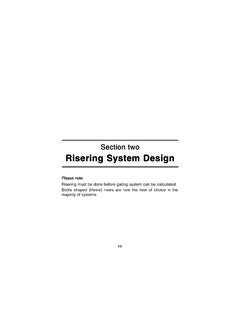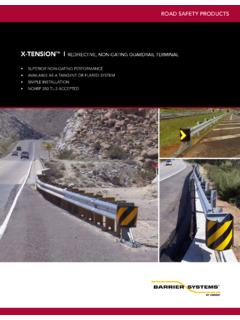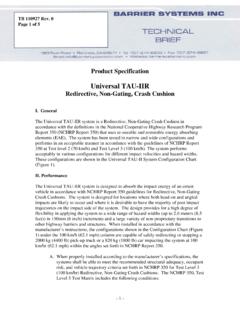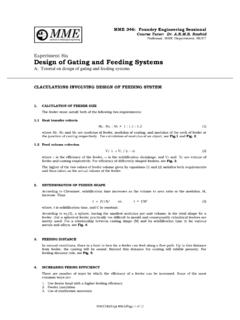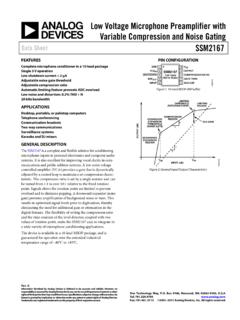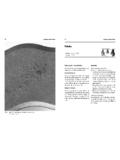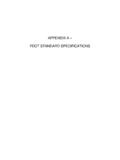Transcription of Rio Tinto Iron & Titanium - Sorelmetal
1 Rio Tinto iron & Titanium DUCTILE IRONThe essentials of gatingand risering system designRevised in 2000 DUCTILE IRONThe essentials of gatingand risering system designPublished by:770 Sherbrooke Street West Suite 1800 Montr al (Qu bec) CanadaH3A 1G1 Rio Tinto iron & Titanium .. SYSTEM DESIGN .. Components .. Role of Choke .. of gating System Type .. Time .. Cross Sectional Area .. Configuration .. Sprue Design .. Runner Bar .. Gate Connection .. Pouring Basin and Sprue Well .. Common Defects Relating to Poor GatingSystem Design .. Case History .. Molten Metal Filtration .. SYSTEM DESIGN .. Components .. Following are Suggested by Researchand Supported by Industrial Experience.
2 Volume Change Patterns .. Rate .. Quality .. iron Processing .. of Risering Method .. Pressure Control Risering .. Bottle Riser .. Riserless Design .. Directly Applied Risering Design (DAR) .. Selection of Pouring Temperature Basedon Risering Method .. Pressure Control Risering & Bottle RiseringCase Histories .. 33-37, Metallurgical Quality Control .. Methods to measure Metal Quality .. Other Risering Aids .. Chills .. 40 BIBLIOGRAPHY ..443 TABLE OF CONTENTSThe importance of casting soundness and produc-tion economy, as influenced by gating and riseringpractice, has been recognized for many years byRIT s producers of high purity iron QIT - Fer et TitaneInc.
3 (QIT) and Richards Bay iron and Titanium (Pty)Limited (RBIT). Indeed, it can be accurately describedas being a RIT tradition of interest and involvement inthis area of castings production. The pioneer in thiswork was Dr. Stephen I. Karsay and his book entitled Ductile iron III gating and Risering has formed thebasis for this present seminar/lecture notes addition to Karsay s groundwork, a number of otherRIT technical service personnel have made valuablecontributions towards RIT s present approach to thetask of gating and risering. True to tradition, RIT hasclosely followed the results and experiences of othersworking in this field and, where appropriate, has incor-porated some of these into its presentations on set of seminar/lecture notes forms the basis forgating and risering presentations which are regularlygiven around the world to groups of foundrymen atseminars and meetings organized either by RIT and itsagents or in conjunction with foundry notes are not intended to be a comprehensivetreatment of the subject but rather to give the essen-tial features of RIT s approach in a form, that is easy touse and apply.
4 For those who require a more detailed,in depth, treatment of the subject, see the is indebted to the foundries and foundrymen whohave contributed in many ways over the years during thecontinuing quest to arrive at a generally acceptable andsuccessful approach to the task of gating and riseringDuctile iron makes no claim to have discovered the ultimateformulae , but suggests that these notes provide a sen-sible and logical approach to a problem which dailyconfronts foundrymen namely, the economic pro-duction of clean, sound Ductile iron has made every reasonable effort to ensure thatthe data presented accurately represents the informa-tion contained in the many sources from which it wasobtained and, when necessary, attempts have beenmade to reconcile data from different sources whichdo not agree.
5 Therefore RIT believes that all informationgiven is accurate and is provided in good faith, butwithout any warranty, either express or implied. Thisbook is protected by copyright and no part of it can bereproduced, stored in a retrieval system or transmittedin any form or by any means without the prior writtenpermission of Rio Tinto iron & Titanium 2000 by Rio Tinto iron & Titanium oneGating System DesignPlease note:The reader should note that the risering of a casting mustbe done before the gating system is designed or gating SYSTEM Requirements: Fast pouring to: Minimize temperature loss duringmould metallurgical fade .Minimize oxidation. Clean pouring to: Avoid slag (dross) generation out slag from first iron poured into mould.
6 Economic Design: Maximize casting Essential Components:All components shown are necessary to minimizeoccurence of slag Planning:Generate a basic layout by considering: optimumspace utilization for castings; chosen risering method;place parting to minimize need for cores; castingslocated in cope, fill quietly; simple, symmetrical system;identical gating and risering for identical castings; useone riser for more than one casting if possible; LEAVEROOM ON PLATE FOR ADEQUATE gating ANDRISERING design The Role of Choke : Definition: Choke is that cross sectional area in agating system which determines mould filling time. There are two correct locations for the choke,hence two basic gating system types:6 Choke located at junction ofrunner and gate in a simpleGATE-RUNNER(pressuriz-ed) located at junction ofsprue and runner in a simpleSPRUE-RUNNER(non-pressurized) Selection of gating System Type: In a GATE-RUNNER system castings are chokedindividually by one or more chokes or gates.
7 With aSPRUE-RUNNER system it is possible for severalcastings to share a common choke. Use SPRUE-RUNNER system for large number of small castings in one mould where it is impracticalto choke the castings individually where chokedimensions are very small very demanding onmoulding technique and pouring temperature. Use GATE-RUNNER system on most other occa-sions. Features of GATE-RUNNERand SPRUE-RUNNERSYSTEMScan be combined to form a HYBRIDsys-tem. This is normally used where a complicatednetwork of runners is required to deliver iron tocasting Friction: Not all potential energy of liquid at top of sprue isconverted to mechanical energy at casting cavity. Some potential energy lost to friction (heat) as li-quid moves against mould wall and liquid movesagainst liquid.
8 Energy loss due to friction extends mould fillingtime and must be taken into account whencalculating choke cross sectional area and pouringtime. Energy loss estimated by selecting value of fr ,frictional loss factor. for thin plates , for heavy cubes , WEIGHT WEIGHT lbsfr110 100 1,000 10, 10 100 1000 10000 Pouring Time: As fast as possible consistent with human abilityand production routine. Recommended pouring times: very approximate guide, t sec = (W. lb)(W = weight of castings + risers) Choke Cross Sectional Area (Ac.): Select fastest practicable pouring time (t.)
9 (sec.) fortotal poured weight (section ). Select suitable fr value. (Section ) Determine total poured volume/choke (V.)( , ) V is volume of all castings plus risers, downstreamof a particular choke. Volume = liquid iron , density = lb/in3or Kg/cm3. Determine effective ferrostatic head in sprue (H.)(in., cm.) Determine height of casting in cope (b.) (in., cm.) From Torricelli, velocity of iron stream at choke is,vc= fr2gH When casting located entirely in drag,VDAc=(b = 0) H(g = acceleration of gravity = 386 in/sec2or981 cm/sec2) When casting located entirely in cope, (b) VCAc = 2g [ H3 (H b)3] When casting located in cope and drag,1 VD+ (b)VcAc= 2g H H3 (H b)38 Total Poured Weight (Incl.)
10 Risers) Per Choke. Time 10 100 1,000 10,000 Total Poured Weight (Incl. Risers) Per Choke. Time 10 100 1,000 10,000 A reasonably accurate guide to suitable Accan beselected from these plots: Plot data is based on averagecope heights whichwill vary from foundry to foundry. In the majority ofcases this introduces negligable error. Mould filling process should be timed and if actualfilling time is significantly different from selected fill-ing time, choke should be redesigned according toabove Choke Configuration:GATE-RUNNER: The total choke cross sectional areais the sum of individual gate cross sectional areas: Total choke = Ac= A1+ A2+.
